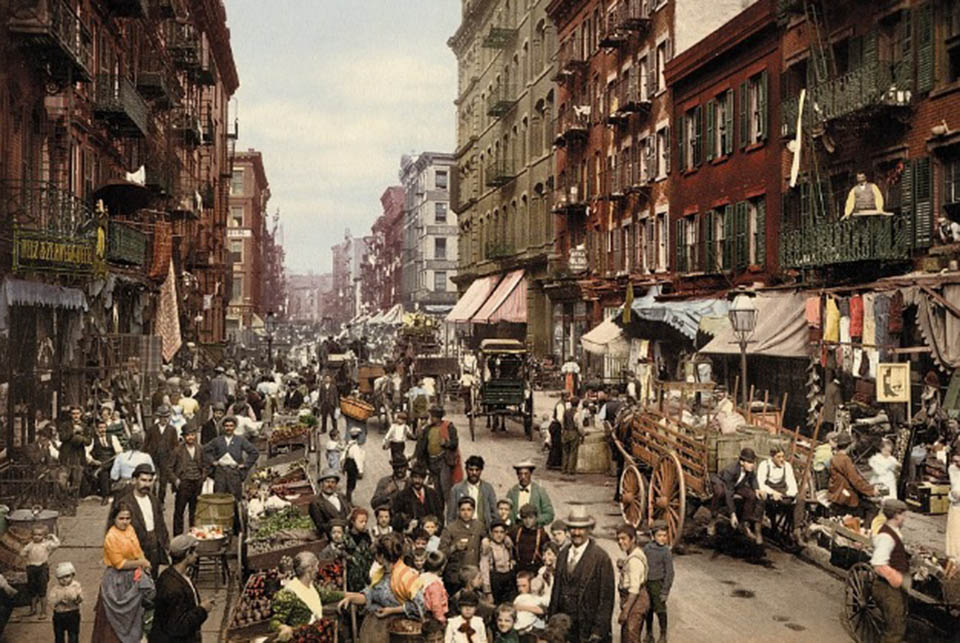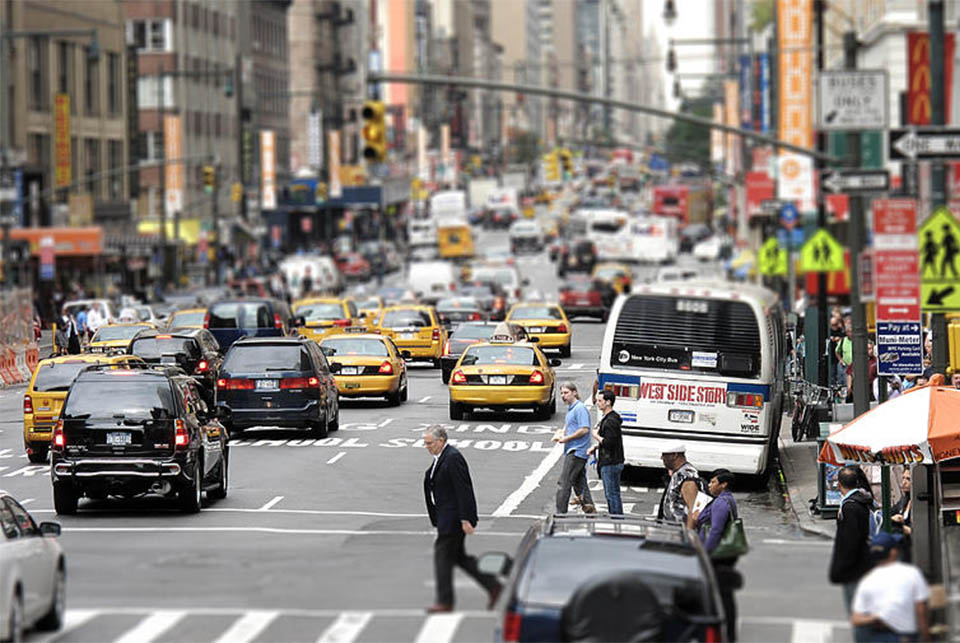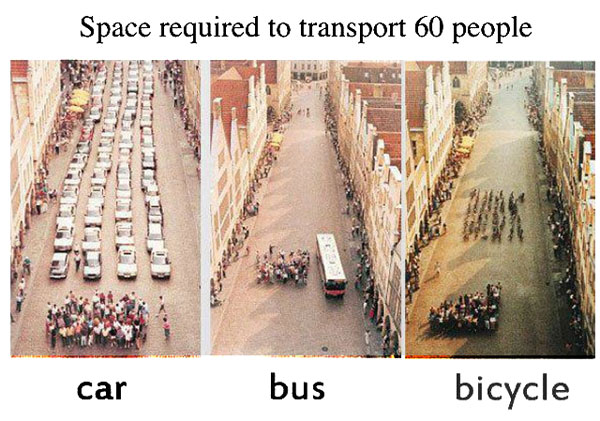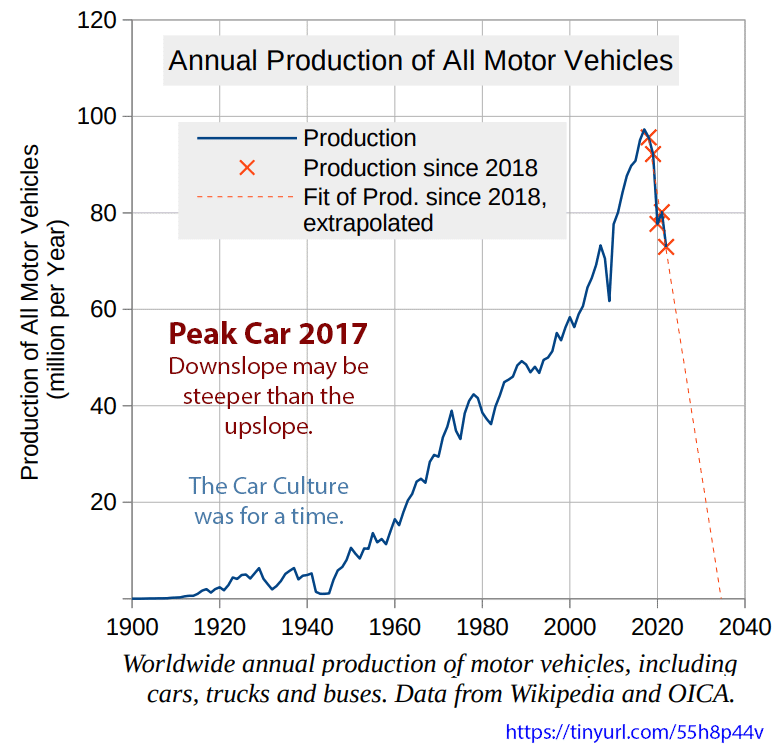
SATURDAY, MAR 26, 2015

The Post-Car Culture
Why the passing of another Golden age is thinkable
Eric Lee, A-SOCIATED PRESS
"The worst mistake in modern civilization is allowing excess automobile horsepower.... That is, we run cars and build throughways instead of asking what is the most appropriate transportation to make an optimal fit of people and environment." —H.T. Odum interview, 2001
TOPICS: CAR CULTURE , FROM THE WIRES, FUSION, BIOFUEL, SURVIVAL ISSUES
Abstract: 'And this too shall pass away.' In the car culture transitioning to electric cars 'that peal the edges of your face back' per an early Tesla ad, is thinkable. A world without cars could only reference history or backward, primative regions of today's world, which have no application to any future to be envisioned other than by 'doomers'.
TUCSON (A-P) — The Golden age of bicycles, 1880-1915, passed as cars came to dominate wheeled transportation. The Golden age of cars too shall pass away, as will the cheap fuel that powers them. They will again become toys of the rich.....
But surely, while fossil-fueled cars may pass away, they will merely come to be powered by alternative fuels such as electric or hydrogen, and the Car Culture will go on and on.....
These two possible futures will depend on whether energy becomes more or less abundant. Less energy means the end of life as most now know it. Less, however, may be the future most devoutly to be wished for. Technological optimists question only what source of power will provide energy so abundant it will be 'too cheap to meter': nuclear, geothermal, fusion, solar, wind, hydro, tidal, wave, biofuel, zero-point, Dilithium crystals, a Dyson sphere, or some combination of all. The often unstated thought is: "so that exponential growth can continue forever."
Electric and hydrogen are forms of fuel, not ultimate sources. Electric can be stored in capacitors or batteries, and transported by wire, while hydrogen can be stored as a compressed gas or chemically, and transported by pipe, yet neither makes itself. There are other forms of fuel, but only two sources: fusion and fission (other than prehistorical ones which includes geothermal, tidal, as well as fossil biofuels). Fission reactors have occurred naturally in Earth's crust in its early history, and occurs today in nuclear reactors where it is turned into heat/steam/electric power, which in turn could be turned into hydrogen and other fuels.
The above feels good to believe. Enthusiasm for feel-good beliefs is rarely diminished by their being delusional. "People would rather believe than know." —E.O. Wilson. Restate slightly: "LITHIUM IS THE FUTURE: Welcome a new energy renaissance fueled by lithium – a clean, affordable and safe energy that can be easily produced in unlimited quantities on demand. LITHIUM IS THE FUTURE. Say goodbye to dirty, deadly sources of power." Elon Musk's director of marketing would be tempted to agree.
That lithium is less common, not as "unlimited" as hydrogen, that some pointy-headed know-nothings say is "rare" for some reason, is a detail that diminishes belief in such a claim. Hence "HYDROGEN" is favored by the oversellers as even those who consider themselves scientifically literate will fall for it. That hydrogen is far less limiting than lithium, that when we run out we can just go to the sun and scoop up more, is easy to believe. For some reason we cannot use hydrogen to generate electricity for electrolysis of water to make more hydrogen gas. That hydrogen is not a fuel/energy source, is, well, merely an inconvenient truth best overlooked.
Energy is required to produce hydrogen. To produce large amounts you need a large source of fuel/energy. Stored hydrogen is a form of "fuel" as energy storage, like lithium batteries. Neither are a source/fuel. We can unoxidize water to make hydrogen, we can unoxidize carbon dioxide to make oxygen. We can recombine and use some of the energy released to drive cars. We could scoop up hydrogen from the sun to power bicycles at high speed but that would likely take more energy than could be produced by combining it with oxygen produced by solar energy by plants on Earth. There is no nearby place to scoop up oxygen. Turning fossil fuel into hydrogen is a feel-good technology currently oversold by and to those who would rather believe than know. Why believe in the second so called law of thermodynamics when you can believe what you want to?
Fusion is the source of all other fuels, including fossil ones. The sun is a fusion reactor and is the source of wind, hydroelectric, wave, biofuels, and solar electric. Fission power is a proven source, fusion power apart from in the sun, is not.
So it comes down to nuclear fission power plants or solar fusion as Earth-based fusion is merely another oversold want. If nuclear fission were used to fuel continued exponential growth, the world's uranium supplies won't last, and the Nuclear Age will be shorter than the Fossil Fuel Age. The certainty that technologists will create fusion reactors on Earth is a hope, a prospect, and for many a faith-based belief. Creating a fusion reactor on Earth is not needed as we have a fusion reactor 93 million miles away that has been supporting life on Earth for a few billion years and is good for a few 100's of millions of years to come. But no one owns it.
The Car Culture is one expression of the over-arching Growth Culture. The first cars were electric, but newly discovered petroleum reserves were there for the taking, so something that guzzled it was needed, and Ford had a better (for Rockefeller) idea, so Ford it was. Mass production began in 1913 and cars overpowered bicycles within a few years. The work day was reduced to 8 hours so three shifts could work around the clock.
The streets of the city once looked like:

,,,,a human place, a meeting place, a playground for children.
But to make them look like:

...the well moneyed had to remove the people from their (the rich and growing middle class car owner's) streets, which, for some reason, the majority opposed. In 1921 over a thousand children in New York City, about 20 a week, were killed by cars. By 1925, in cities with populations over 25,000, cars were killing two-thirds of those who happened to die from all causes. Today cars remain the leading cause of death in America of those between ages 3 and 34, and the indirect cause for those over 34 secondary to activity intolerance. But unlike today, people in the early twentieth century were outraged, were mad as hell, and weren't going to take it anymore. Up until 1923, newspapers reflected their readership, and editors and letters to the editors squarely blamed motorists for the carnage.
The motorists, the wealthy and would-be rich, had to act fast. They managed, using the(ir) media, lawyers, lobbyists, and politicians, to claim that the carnage was the fault of pedestrians who didn't know they shouldn't step into the street. They relentlessly promoted the claim that only idiotic country hayseeds (jays: empty-headed rural bluejay-like chatterboxes) would step into traffic. A lie told often enough, as usual, became the putative truth. They managed to criminalize what had been the norm, what the majority favored, and lobbied for laws against "jaywalking." By the end of 1924 newspapers had come to champion the deeply held concerns of their advertisers by squarely blaming the carnage on walkers. By 1927, the conquest of the streets in all major cities had been achieved. Government of the money, by the money, and for the moneyed had prevailed.
Early shopping centers were made without sidewalk or bicycle access. But elsewhere pedestrians were allowed a narrow strip between buildings and parked cars since all businesses were not drive-ins or drive-throughs. Drivers still walked from their garage into their suburban home, accessible only by car, and from their car to place of work or place of shopping, so sidewalks had their use. Bicyclists were allowed to fend for themselves. The Car Culture had cometh.
The Car Culture was manufactured by the Growth Culture's advocates who profited all the way to the bank by promoting consumerism, the consumer way of life, and the more-is-better consumer society. "Labor saving" became the oft repeated mantra, which, translated, means "movement saving" activity intolerance. The thought that the passing of the Car Culture is unthinkable is also manufactured, as are its consumers (formerly known as citizens) collective inability to consider limits to growth. The real problem is not finding alternative fuels, even given that the failure to do so will put an end to growth and to the Growth Culture. The ultimate unthinkability is that we might find alternatives to cheap fossil fuel (e.g. fusion, or worse, everything else) and that exponential growth will continue until the entire surface of the planet and all crustal resources have been consumed. The concern is not that the Car/Growth Culture might end, but that it won't pass soon enough. We of the Anthropocene will have an era named after us, but an era that may be defined by they who are presiding over the greatest mass extinction since the late Cretaceous.
 A Post-Car Culture will have another name
and will say "no" to maximizing growth, consumption,
speed, and the high-powered life. Thoughts of "MORE!" will
be replaced by thoughts of "enough." Unlike growthers,
"enoughers" will try to know their wants from their needs,
and focus on their needs (as in actual needs) as distinct
from manufactured wants they are incessantly told they
need. Doing so is an act of revolution, an act of
rightness. The collapse of the Car/Growth Culture will be
the falling in of a rotten door, a clearing the way for a
functional life. As Gandhi noted, “The world has enough
for everyone's need, but not enough for everyone's greed.”
For "greed" read "wants" and for "everyone's" read "a
limited number of people's," and you'll have a basic grasp
of matters.
A Post-Car Culture will have another name
and will say "no" to maximizing growth, consumption,
speed, and the high-powered life. Thoughts of "MORE!" will
be replaced by thoughts of "enough." Unlike growthers,
"enoughers" will try to know their wants from their needs,
and focus on their needs (as in actual needs) as distinct
from manufactured wants they are incessantly told they
need. Doing so is an act of revolution, an act of
rightness. The collapse of the Car/Growth Culture will be
the falling in of a rotten door, a clearing the way for a
functional life. As Gandhi noted, “The world has enough
for everyone's need, but not enough for everyone's greed.”
For "greed" read "wants" and for "everyone's" read "a
limited number of people's," and you'll have a basic grasp
of matters.
There are many potential futures; pick
one.

Peak Car?

---------------------------------------------------------------------
SUBNOTE TO FILE 1/17/23 from The Guardian
‘Motonormativity’: Britons more accepting of driving-related risk
Allowance made for dangers that would not be accepted in other parts of life, finds study with potentially major policy implications
[Humans of the car culture, who drive cars or not,] appear to have an in-built acceptance of risks and harms from motor vehicles that they would not accept in other parts of life.... Such is the cultural ubiquity of these assumptions, described by the researchers as “motonormativity”, that politicians are less likely to try to tackle issues such as pollution from vehicles or poor driving.
In one example 75% of people agreed with the statement: “People shouldn’t smoke in highly populated areas where other people have to breathe in the cigarette fumes.” But when just two words were changed – “people shouldn’t drive in highly populated areas where other people have to breathe in the car fumes” – only 17% agreed. Similarly, while only 37% of people thought the police needed to take action if someone left their “belongings” in the street and they were stolen, with the word changed to “car” it rose to 87%. In another question, 61% of people agreed that risk was “a natural part of driving”, whereas just 31% agreed when “driving” was changed to “working”.
...the responses stayed similar even when the researchers examined those only from people who did not drive.
...drivers tend to overtake male cyclists more closely then female ones, and to pass nearer to riders wearing helmets...
"... if you asked that same politician whether a hospital should be built on the edge of town, it’s likely that many wouldn’t see the problem, if they have a form of this mindset we’re looking at. But in practice, having the hospital outside town is not that different from making it inaccessible when a fifth of households don’t have a car."
As noted above:
Early shopping centers were made without sidewalk or bicycle access. But elsewhere pedestrians were allowed a narrow strip between buildings and parked cars since all businesses were not drive-ins or drive-throughs. Drivers still walked from their garage into their suburban home, accessible only by car, and from their car to place of work or place of shopping, so sidewalks had their use. Bicyclists were allowed to fend for themselves. The Car Culture had cometh.
